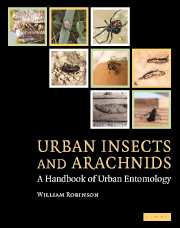Book contents
- Frontmatter
- Contents
- Preface
- Part I Urban entomology
- Part II Insects in the urban environment
- 4 Blattaria
- 5 Coleoptera
- 6 Collembola, Dermaptera
- 7 Diptera, Ephemeroptera
- 8 Hemiptera, Homoptera
- 9 Hymenoptera
- 10 Isoptera
- 11 Lepidoptera
- 12 Mantodea, Neuroptera
- 13 Orthoptera, Phasmatodea
- 14 Phthiraptera
- 15 Plecoptera, Psocoptera
- 16 Siphonaptera
- 17 Thysanoptera, Thysanura, Trichoptera
- Part III Other arthropods in the urban environment
- Family, genus, species index
- Index
- References
- Frontmatter
- Contents
- Preface
- Part I Urban entomology
- Part II Insects in the urban environment
- 4 Blattaria
- 5 Coleoptera
- 6 Collembola, Dermaptera
- 7 Diptera, Ephemeroptera
- 8 Hemiptera, Homoptera
- 9 Hymenoptera
- 10 Isoptera
- 11 Lepidoptera
- 12 Mantodea, Neuroptera
- 13 Orthoptera, Phasmatodea
- 14 Phthiraptera
- 15 Plecoptera, Psocoptera
- 16 Siphonaptera
- 17 Thysanoptera, Thysanura, Trichoptera
- Part III Other arthropods in the urban environment
- Family, genus, species index
- Index
- References
Summary
Introduction
Adults and caterpillars of butterflies, moths, and skippers are found in nearly all environments and are well known to everyone. Adults are characterized by having their wings and other parts of their body covered with a layer of short, flattened setae, or scales. The two pairs of wings are usually broad, subtriangular, and with the front pair larger. The mouthparts, when present, are a coiled proboscis or tube for siphoning liquid. The noctuid Calyptra eustrigata has a strong proboscis, which enables it to pierce the skin of mammals and suck blood. Moth antennae are usually thread-like or feather-like, while butterfly antennae are thread-like and clubbed at the tip. Butterflies fold their wings vertically above the body when at rest, while moths hold their wings rooflike or close around the body. They undergo complete metamorphosis.
Caterpillars are usually cylindrical, and besides the head there are three thoracic segments, and 10 abdominal segments. Thoracic segments bear a jointed leg, which terminates in a single claw. Abdominal segments bear unjointed, fleshy projections or prolegs. Typically there is one pair on segments 3–6, and 10, but some or all of the prolegs may be absent. Caterpillars have silk glands that open at the mouth; they use silk to make feeding shelters and to protect the pupal stage. Pupae are usually encased in a protective structure formed by the last caterpillar stage.
- Type
- Chapter
- Information
- Urban Insects and ArachnidsA Handbook of Urban Entomology, pp. 328 - 345Publisher: Cambridge University PressPrint publication year: 2005



